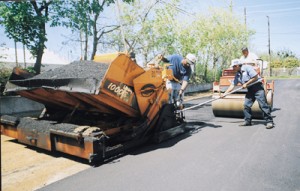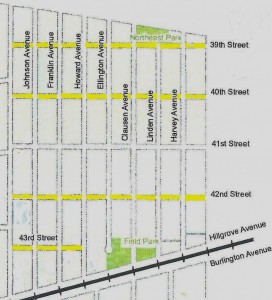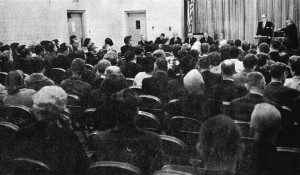In 1967, most residents of Western Springs’ Field Park were opposed to letting the Village pave their streets. Especially since they’d have to foot the bill.

Asphalt Spreader
Roughly one-fifth of Western Springs’ residents live in the Field Park area. Most of them never think twice about which street to take on a shopping trip or when leaving for work. But, it wasn’t that way just 46 years ago. That’s when most of the east-west streets between Gilbert and Wolf were still unpaved.
As background, the Field Park Civic Association, which was comprised of residents who paid $3 in annual dues, had a street maintenance arrangement with the Village for many years. Each spring, the Village would fill the potholes with gravel and re-grade the unpaved east-west streets. The association would then pay to have an oil mixture applied to bind the gravel. Of course, the results were short-lived, were not on a par with asphalt, and the streets lacked curbs and sewers.
Potholes and mud were a frequent hazard to motorists, especially in the winter and spring. In fact, one resident reported that cars would drive down the parkways when the streets became impassable. While 41st Street was paved, 39th, 40th, 42nd, and 43rd were not. See photo. As a result, most local motorists would avoid those roads at all costs.

Field Park’s unpaved streets – 1967
You might think that the homeowners on those streets would demand that they be paved. But, you would be wrong. Since residents in other parts of the village had been previously assessed the cost of such improvements on a prorated basis, most Field Park homeowners said they were happy with the status quo. In fact, a 1966 survey of Field Park residents showed 58% against paving.
Many homeowners in this area believed that their children were safer since cars couldn’t traverse the streets at more than 5 or 10 miles per hour. Others said the gravel roads made the area “more quaint” or country-like. Others feared that adding new sewers would overtax the existing north-south sewers and cause flooded basements. And, some just didn’t want to see an increase in their tax bill.
By 1967, the Association’s fund-raising efforts were waning and their treasury was nearly depleted. This meant that the roads might get even worse. As a result, the Village began obtaining estimates from contractors for the construction of new sewers, curbs, and gutters, as well as actual street paving. However, this would be done at the expense of the homeowners.
Almost immediately, a petition was circulated among Field Park residents opposing the project. With the cost of the project pegged at $228,600 (or $1.5 million in 2013 dollars), residents were understandably nervous about the size of their assessments. At a special public meeting, residents were even more vocal.
One resident asked, “Why install a superhighway when the need does not exist?” Another stated that “… the project is neither economically justified nor physically desirable.” Another told the Board that, if their petitions were not sufficient, the objectors could stage demonstrations to convey their displeasure.
But, the most interesting response was from a resident who proposed that the village simply close all of the unpaved east-west streets and sell the vacated land for new homes. He argued that there wasn’t even a need for most of the cross streets and that residents wouldn’t object to driving the extra distance to go east or west.

Capacity crowd of Field Park residents – 1968
Fortunately, those in favor of the proposed improvements also had their say. One of them recalled seeing five cars mired in mud while trying to pass by his home on 40th Street. Another recalled a semi-trailer being stuck in the middle of his muddy street, just spinning its wheels. A third resident speculated that, if the project were deferred, the cost would be at least $400,000 in another ten years.
In June 1968, the Village Board approved the proposed improvements and assessments, more than a year after they were first proposed. But, 49 objectors filed suit seeking that the assessments be adjusted. After further negotiations, the Village reduced the assessments by $11,130, thus satisfying the Court and clearing the way for actual construction in 1969. Thus ended the village’s last major battle against paved streets.
